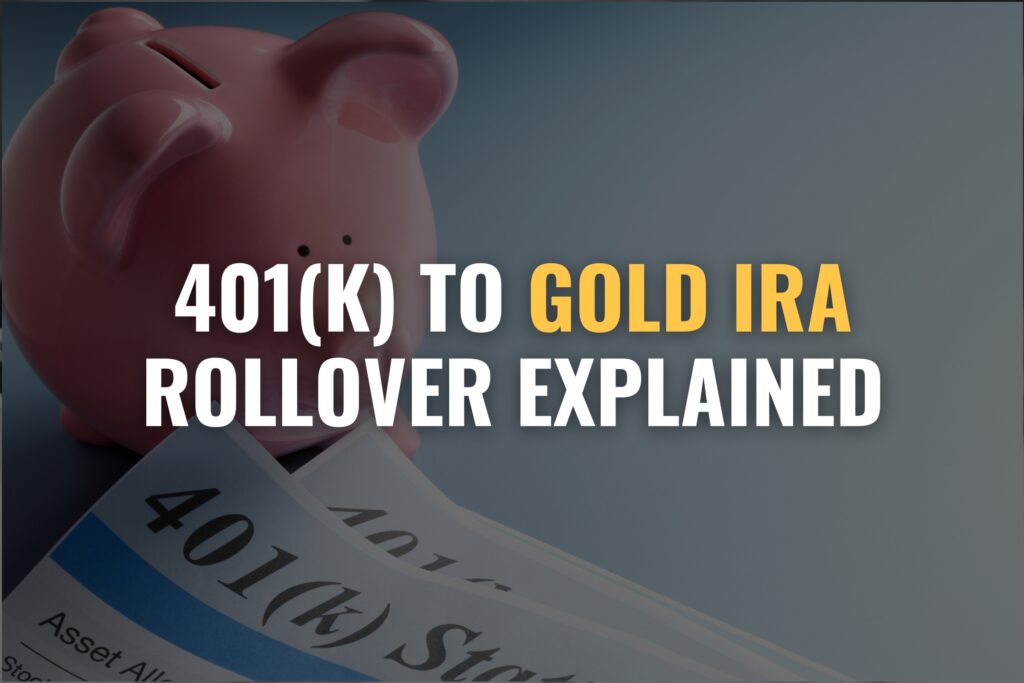How to Execute a 401(k) to Gold IRA Rollover

Transferring funds from a 401(k) to a gold IRA through a rollover can offer a smart approach to spreading out your retirement investments. This option allows you to explore new possibilities for your 401(k) savings by gaining exposure to precious metals.
However, investing in gold comes with its own set of advantages and challenges that need careful thought. The process can be complex, so it’s wise to seek advice from a financial expert. They can clarify the benefits of this move and highlight any risks involved, ensuring you make an informed choice.
In this article, we will explain the steps involved in 401(k) to gold IRA rollover, benefits of investing, and considerations for completing this financial move.
Key Points to Keep in Mind
- A gold IRA is a self-directed individual retirement account designed to hold physical precious metals like gold, silver, platinum, or palladium. It provides a way to diversify your portfolio and protect your savings from inflation. Unlike traditional 401(k) plans, which typically focus on stocks, bonds, or mutual funds, a gold IRA allows you to invest in physical metals.
- In times of market uncertainty and crises, gold often performs differently from stocks and bonds, helping to lower overall investment risk. It has a reputation of a safe-haven asset that can protect investors from inflation and weakening dollar.
- To transfer your 401(k) to a gold IRA, you need to open a self-directed individual retirement account with a custodian experienced in handling precious metals. Then, you have to request a direct transfer of funds to your new gold IRA custodian and purchase gold that meets IRS purity requirements.
- Keep in mind that it’s better to opt for a direct transfer to avoid potential tax penalties or complications. Gold IRAs often include costs for setup, yearly maintenance, storage, and transactions. Your gold must be stored in an IRS-approved facility, such as Brink’s Global Services or Delaware Depository. Some gold ira companies may require a minimum investment amount to open an account.
What a Gold Individual Retirement Account Is?
For centuries, gold has been a reliable choice for protecting wealth. If you have already retired or are approaching retirement, a preferable way to invest in it is through a self-directed gold individual retirement account (IRA). This type of retirement account holds physical gold or other permitted precious metals, such as silver, platinum, or palladium, instead of typical investments like stocks or bonds.
A gold IRA lets you include tangible precious metals in a tax-advantaged retirement plan. This can provide unique advantages, especially for those looking to shield their savings from inflation or economic uncertainty.
Unlike standard IRAs, which often include a mix of financial assets, gold IRAs focus solely on precious metals. By choosing this option, you’re investing directly in physical gold bars or coins, not in gold-related stocks or funds.
Why Do Investors Choose Gold?
If you’re considering adding gold to your retirement portfolio, here are four key reasons why investors often turn to this precious metal:
Reliable asset: Gold is widely valued during economic uncertainty due to its stability. When other investments appear volatile, demand for gold often rises, which can drive its price higher.
Protection against inflation: Gold serves as a shield against rising prices. Its value tends to hold steady or grow when inflation accelerates, especially during economic challenges when governments increase the money supply.

Portfolio balance: Gold typically behaves differently from stocks and bonds, often retaining or gaining value when other assets falter during economic slumps. Including gold can help lower the overall risk in your investment mix.
Proven track record: In times of financial turmoil, such as the Great Recession, gold prices climbed as investors sought its safety. As of May 2025, gold reached an all-time high of nearly $3,075 per troy ounce, fueled by Donald Trump’s tariffs on steel and aluminum imports.
Benefits and Drawbacks of a Gold IRA Investment
A gold IRA can bring several advantages for investors. Main benefit of the gold IRA is that gold counters inflation and offers diversification of your wealth. Gold also tends to hold its value over the long term, helping to preserve your wealth against rising costs and weakening currencies.
| ✅ | Gold often moves independently of stocks, bonds, and other common investments. Including it in your retirement portfolio can help lower overall risk. |
| ✅ | Gold has long been valued as a shield against inflation. Its price tends to remain stable or rise when the value of paper currencies weakens due to increasing prices. |
| ✅ | Gold is often viewed as a reliable asset during economic or geopolitical turbulence. It tends to appreciate in price when uncertainty drives demand. |
| ✅ | Depending on whether you opt for a Traditional or Roth Gold IRA, you may be eligible for tax-deductible contributions or tax-free withdrawals during retirement. |
| ✅ | Many investors appreciate the tangible nature of gold. Owning physical metal can offer a sense of stability compared to relying entirely on digital or paper-based investments. |
During times of economic uncertainty or global tensions, gold often appreciates, making it a favored choice for stability. However, gold IRAs come with specific costs, such as storage and insurance fees. Here are five key challenges to weigh before committing:
| ❌ | Gold does not produce regular income, unlike stocks or bonds, which may offer dividends or interest. |
| ❌ | Safely storing physical gold involves extra expenses and logistical planning. |
| ❌ | Gold prices can swing significantly due to market shifts or global events, despite its stable reputation. |
| ❌ | Selling physical gold can take longer and be less straightforward than selling stocks or bonds, potentially delaying access to your money. |
| ❌ | Opting for gold might mean missing out on stronger gains from other investments, especially during robust stock market periods. |
How Does a 401(k) to Gold IRA Rollover Work?
Rolling over a 401(k) to a gold IRA means moving funds from your current 401(k) into a new gold IRA, either directly or indirectly.
In a direct rollover, the money transfers straight from your 401(k) to the gold IRA without you handling it.
In an indirect rollover, you withdraw the funds from your 401(k) and must deposit them into the gold IRA within 60 days to avoid tax penalties. If your 401(k) custodian withholds taxes during an indirect rollover, you’ll need to deposit the full original amount into the gold IRA to prevent additional tax issues.
This approach can enhance your retirement strategy. It diversifies your investments, reducing exposure to risk. Gold also acts as a buffer against inflation and currency declines, safeguarding your savings. Still, you should consider potential drawbacks, including gold IRA rollover fees, the unpredictability of gold prices, and the lower liquidity of physical gold compared to traditional financial assets.
Direct Rollover vs. Indirect Rollover
Gold, a valued precious metal, often gains worth during times of economic instability. Exploring the two types of rollovers (direct and indirect) reveals their distinct features and which might suit your needs best. A direct rollover moves funds straight from your 401(k) to a gold IRA. This option is often preferred for its simplicity, requiring less paperwork and avoiding the gold IRA tax risks tied to indirect rollovers.

In contrast, an indirect rollover gives you temporary control over your funds. You withdraw money from your 401(k) and must deposit it into your gold IRA within 60 days. While this allows brief access to your cash, missing the 60-day deadline can trigger tax penalties. Choosing between a direct or indirect rollover depends on your personal situation and financial goals.
Transferring Your 401(k) to a Gold IRA in Four Easy Steps
The process of shifting funds from your 401(k) to a gold IRA depends on various factors, but it can typically be completed in four straightforward steps:
- Select a Gold IRA Company: Choose a gold investment company with a strong track record, transparent fees, and reliable customer support. Thorough research at this stage is critical to ensure a trustworthy partner.
- Open a Gold IRA Account: Complete the application process with your chosen provider and specify the funding source for your initial investment.
- Start the Rollover Process: Inform your 401(k) plan administrator of your decision to transfer funds to a gold IRA. They will provide guidance and handle the required documentation.
- Purchase Gold: Once the funds are available in your gold IRA, direct your provider to buy gold or other approved precious metals on your behalf.
Tax Considerations for a Gold IRA
Gold IRAs follow tax rules similar to those of traditional IRAs. Depending on your income and whether you or your spouse have a workplace retirement plan, contributions might be tax-deductible. Growth and earnings in the account are tax-deferred, meaning you won’t owe taxes on gains until you begin withdrawals in retirement.
However, withdrawing funds before age 59½ may result in a 10% penalty plus applicable taxes. Additionally, the lower liquidity of physical gold can complicate required minimum distributions (RMDs), which start at age 73, potentially leading to tax penalties if not handled properly. Given the complexity of these tax rules, consulting a tax advisor is recommended to avoid unintended tax consequences.
Warnings About Self-Directed IRAs
When dealing with self-directed IRAs, such as gold IRAs, two major concerns stand out. First, this sector has occasionally faced issues with fraudulent schemes and dishonest individuals targeting unaware investors.
Second, these IRAs come with complex regulations that can be difficult to follow. Mistakes in compliance could lead the IRS to disqualify your IRA, making the entire account immediately taxable.
Conclusion
Gold is often viewed as a stable investment, particularly during periods of market unrest. Converting your 401(k) into a gold IRA can diversify your retirement portfolio and provide a buffer against economic instability. However, it’s essential to recognize the associated risks and expenses.
While this information offers a detailed overview, it is not a replacement for expert financial guidance when planning your retirement. Keep in mind that all investments carry risks, including the possibility of losing your initial investment. Ensure your investment choices reflect your financial objectives and comfort with risk.
